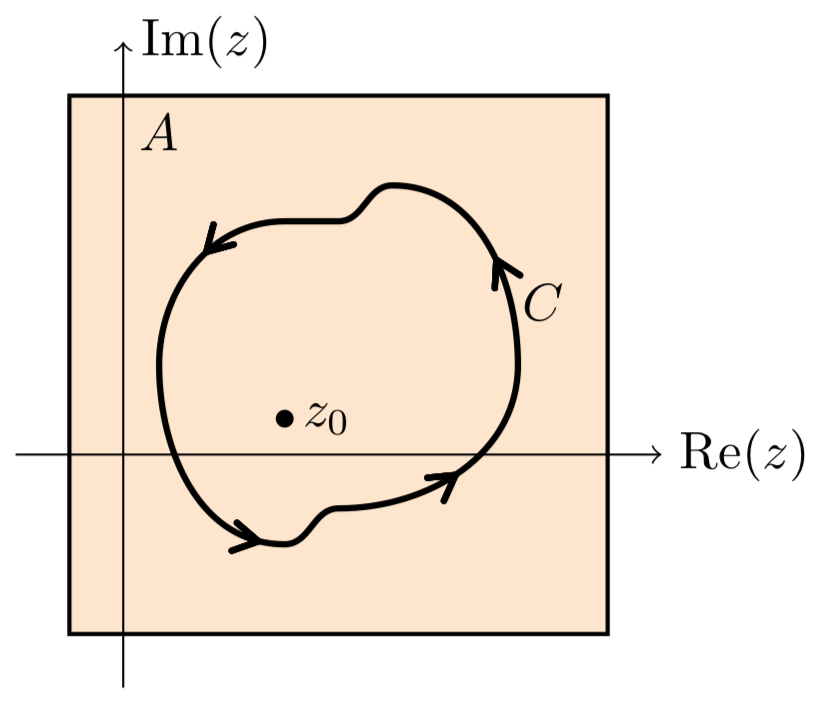5.3: Prueba de la fórmula integral de Cauchy
- Page ID
- 109834
Teorema útil
Antes de probar el teorema necesitaremos un teorema que sea útil por derecho propio.
Teorema\(\PageIndex{1}\): A second extension of Cauchy's theorem
Supongamos que\(A\) es una región simplemente conectada que contiene el punto\(z_0\). Supongamos que\(g\) es una función que es
- Analítica en\(A\) - {\(z_0\)}
- Continuo encendido\(A\). (En particular,\(g\) no por debajo de arriba en\(z_0\).)
Entonces
\[\int_{C} g(z)\ dz = 0\]
para todas las curvas cerradas\(C\) en\(A\).
- Prueba
-
La versión extendida del teorema de Cauchy en las notas del Tema 3 nos dice que
\[\int_C g(z)\ dz = \int_{C_r} g(z)\ dz,\]
donde\(C_r\) es un círculo de radio\(r\) alrededor\(z_0\).

Ya que\(g(z)\) es continuo sabemos que\(|g(z)|\) está acotado por dentro\(C_r\). Diga,\(|g(z)| < M\). El corolario de la desigualdad triangular dice que
\[|\int_{C_r} g(z)\ dz| \le M \text{ (length of } C_r) = M2 \pi r.\]
Ya que\(r\) puede ser tan pequeño como queramos, esto implica que
\[\int_{C_r} g(z) \ dz = 0.\]
Usando esto, podemos demostrar que\(g(z)\) es, de hecho, analítico en\(z_0\). La prueba será la misma que en nuestra prueba del teorema de Cauchy que\(g(z)\) tiene un antiderivado.
Prueba de la fórmula integral de Cauchy
Reiteramos la fórmula integral de Cauchy a partir de la Ecuación 5.2.1:\(f(z_0) = \dfrac{1}{2\pi i} \int_C \dfrac{f(z)}{z - z_0} \ dz\).

\(Proof\). (de la fórmula integral de Cauchy) Utilizamos un truco que es lo suficientemente útil como para que valga la pena recordarlo. Let
\[g(z) = \dfrac{f(z) - f(z_0)}{z - z_0}.\]
Ya que\(f(z)\) es analítico en\(A\), sabemos que\(g(z)\) es analítico en\(A - \{z_0\}\). Dado que el derivado de\(f\) existe en\(z_0\), sabemos que
\[\lim_{z \to z_0} g(z) = f'(z_0).\]
Es decir, si definimos\(g(z_0) = f'(z_0)\) entonces\(g\) es continuo en\(z_0\). De la extensión del teorema de Cauchy justo arriba, tenemos
\[\int_{C} g(z)\ dz = 0, \text{ i.e. } \int_C \dfrac{f(z) - f(z_0)}{z - z_0} \ dz = 0.\]
Así
\[\int_{C} \dfrac{f(z)}{z - z_0}\ dz = \int_C \dfrac{f(z_0)}{z - z_0}\ dz = f(z_0) \int_C \dfrac{1}{z - z_0} \ dz = 2\pi i f(z_0).\]
La última igualdad se desprende de nuestra, a estas alturas, bien conocida integral de\(1/(z - z_0)\) en un bucle alrededor\(z_0\).


